Between September 1970 and October 1971, I made a field study of a troop of free-ranging olive baboons near the village of Gilgil in Kenya. I spent the first three months surveying baboon populations in the area, selecting one troop for a detailed study, and getting that troop accustomed to my presence. In the last eleven months, I spent over one thousand hours observing these animals from as little as ten yards away. I had two objectives: to correlate the way in which the baboons used their range with differing ecological conditions, and to collect information on the behavior of adult male baboons.
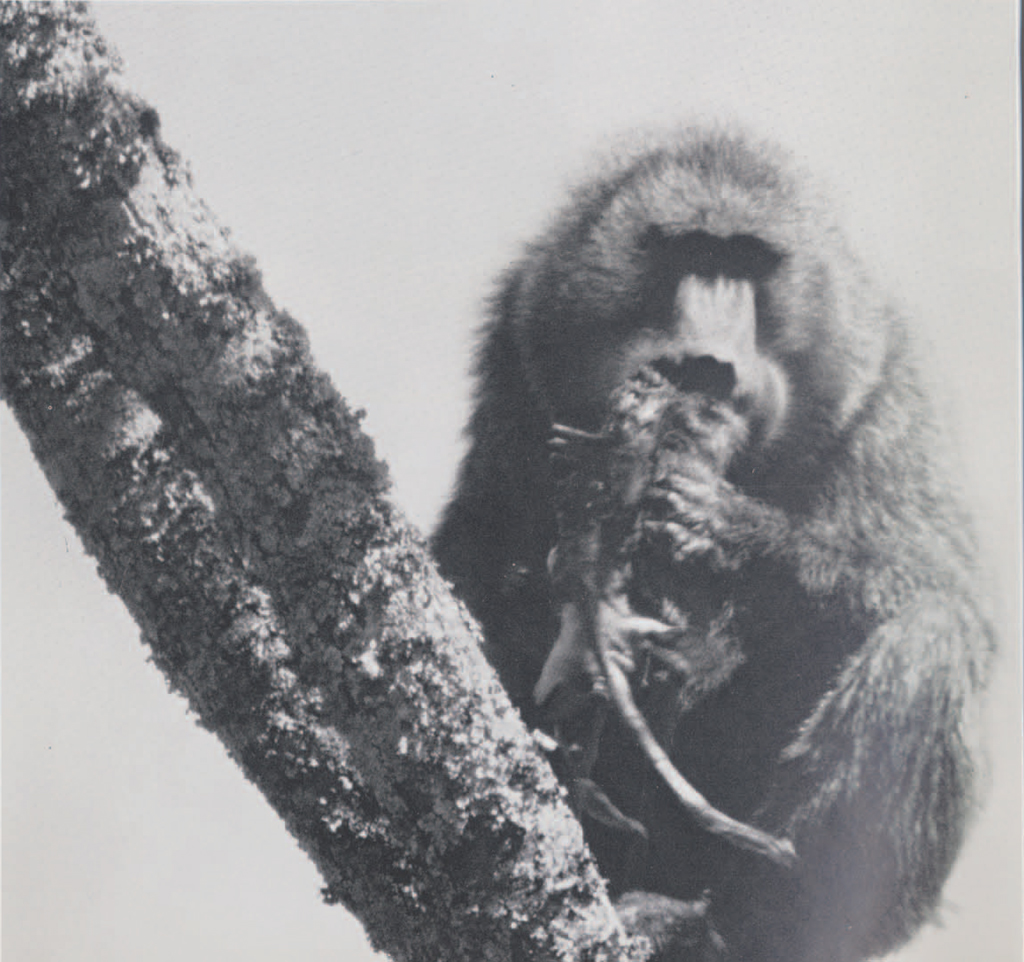
The troop I studied, one of at least seven living in an area of about 17 square miles. spent their days ranging across the parallel valleys of a large cattle ranch an the floor of the Rift Valley. These valleys, separated by tall cliffs up to 300 feet high, were mostly open grassland, interspersed with patches of scrubby bush and stands of a large crown-sprouting shrub called leleshwa.
There have been humans in this part of Kenya for a long time: near the ranch, the Acheulian handaxes of Middle Pleistocene man have been found in quantity at Kariandusi, a site originally excavated by the late Dr. L. S. B. Leakey. More recently, twentieth-century man and his domestic livestock have had a significant effect on the habitat, Predator control programs, undertaken to protect cattle, have presumably reduced the number of big cats in the area, although there are no records available to support this supposition. Lions are only occasional visitors, and leopards have been trapped periodically for removal to national parks, although they were known to exist in the baboons’ home range. Another major change has been the introduction of water in cattle troughs throughout the ranch. Finally, large areas of leleshwa scrub have been cleared to make room for grassland.
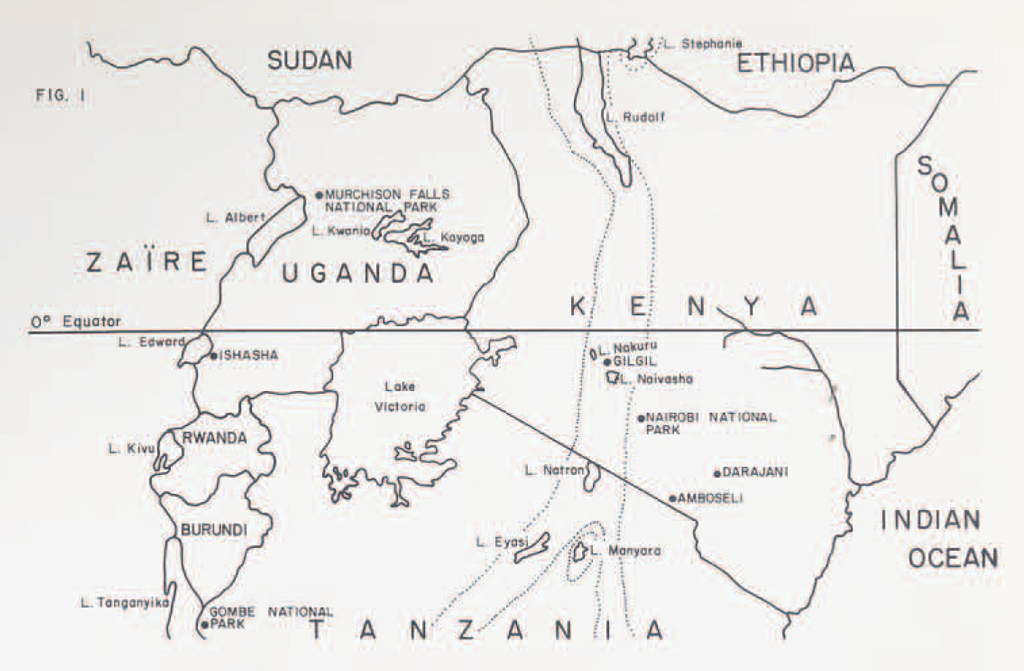
These alterations in the habitat apparently have also caused local populations of hoofed animals to expand. Thomson’s gazelle, which prefer an open habitat and are capable of lambing twice a year, have greatly increased their numbers over the past fifteen years, keeping pace with the range-clearing program. The reduced number of predators may also have contributed to the increase in antelopes; at any rate, at the time of this study scientists from Texas A, and M. University estimated that 2,000 Thomson’s gazelle and 800 impala lived in the area which the baboon study troop used as its home range. Although human intervention in the recent past changed some crucial aspects of the Gilgil baboons’ habitat, at the same time they were relatively free from human harassment, since the country on all sides was used for raising cattle and there were few human crops to serve as a point of conflict with local people. In addition, trapping of baboons for medical research, which has put heavy pressure on baboon populations elsewhere in Kenya, was not permitted on the ranch.
During the course of my study I saw baboons in my study troop catch, kill and eat an unusual number of small animals. This report will describe these events, compare them with similar behavior observed in other nonhuman primates, and discuss their implications for the origin of hunting in the Hominidae, the family that includes man and his immediate ancestors.
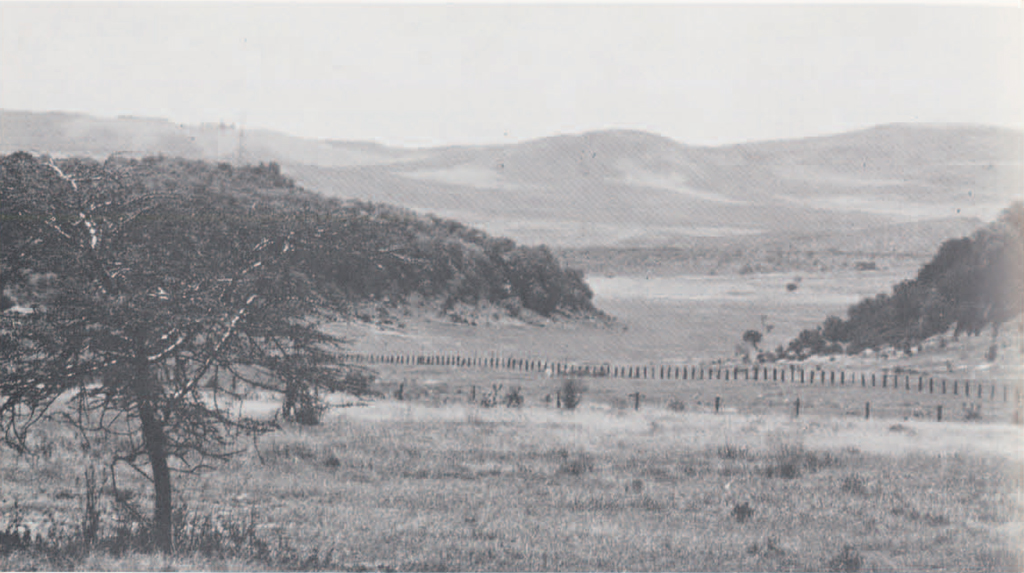
At the outset it is important to understand that baboons, whatever their carnivorous propensities, subsist primarily on vegetable matter. My study of adult male baboons shows that these animals spent about 80% of their feeding time procuring and eating grass seeds, blades and roots, 18G/0 on fruits, seeds, and flowers, and only 2% on sources of animal protein, including beetles and other invertebrates. Nonetheless, I saw the baboons of the study troop kill and eat 47 small animals in just over 1,000 hours of observation, a predation rate far higher than has been reported for any other group of nonhuman primates. The chimpanzees studied by Dr. Jane van LawickGoodall and her associates at the Gombe National Park in Tanzania have killed and eaten more than 95 small animals, but these observations stretch over a decade.
At Gilgil, the preferred prey of the baboons was newborn Thomson’s gazelle infants. Sixteen of these animals were killed and eaten, and small antelope in general, including dikdik, impala, steinbok and others, made up two-thirds of the baboons’ prey. Twelve Cape hares, one button quail, and three small mammals I could not identify constituted the remaining third.
There was some evidence that local, learned tradition played a role in the selection of prey animals, since the baboons of the study troop did not try to catch and kill every small animal of a suitable size, and nearby troops were seen to eat entirely different prey animals. Rock hyrax, a small, furry animal looking rather like a badger, lived on most of the cliffs where the baboons went to sleep at night, and, although baboons and hyrax encountered each other regularly, I never saw a baboon try to catch a hyrax. Subsequent observers in Gilgil have evidence that other troops in the area may prey on hyrax, and elsewhere in East Africa this behavior has been reported as well.
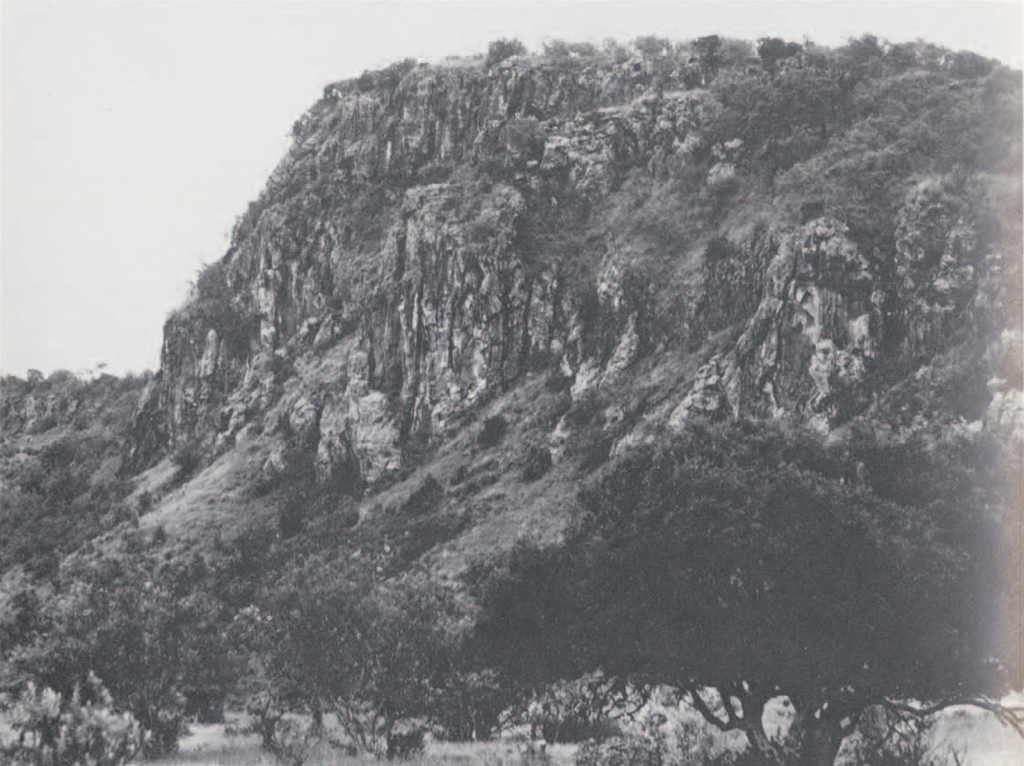
Flocks of helmeted guinea fowl were frequently seen wandering through the baboon troop as it sat eating grass, and, although guinea fowl were often within easy reach of the baboons, they were always ignored. However, another large troop of baboons, whose home range overlapped that of the study troop, caught and ate guinea fowl on several occasions. It is thus clear that different troops have different notions as to what kind of animal is good to eat.
Adult female baboons were seen to catch only three of the forty-seven small animals which the troop killed, and on two of these three occasions the female was chased by an adult male and dropped her prey before she could eat it. The third female was also chased by a male, but her pursuer was distracted when she dropped part of her kill, and she was able to hide behind a bush and finish the rest.
The newborn antelopes, hares and other animals that the baboons killed and ate were all animals that defend themselves against predators by remaining immobile, using available cover to conceal themselves. It is not surprising, therefore, that most kills were made by chance, when a male baboon tripped over a crouching hare, for instance. In one typical example, I saw the baboons move in to feed in a grassy field which had been vacated.
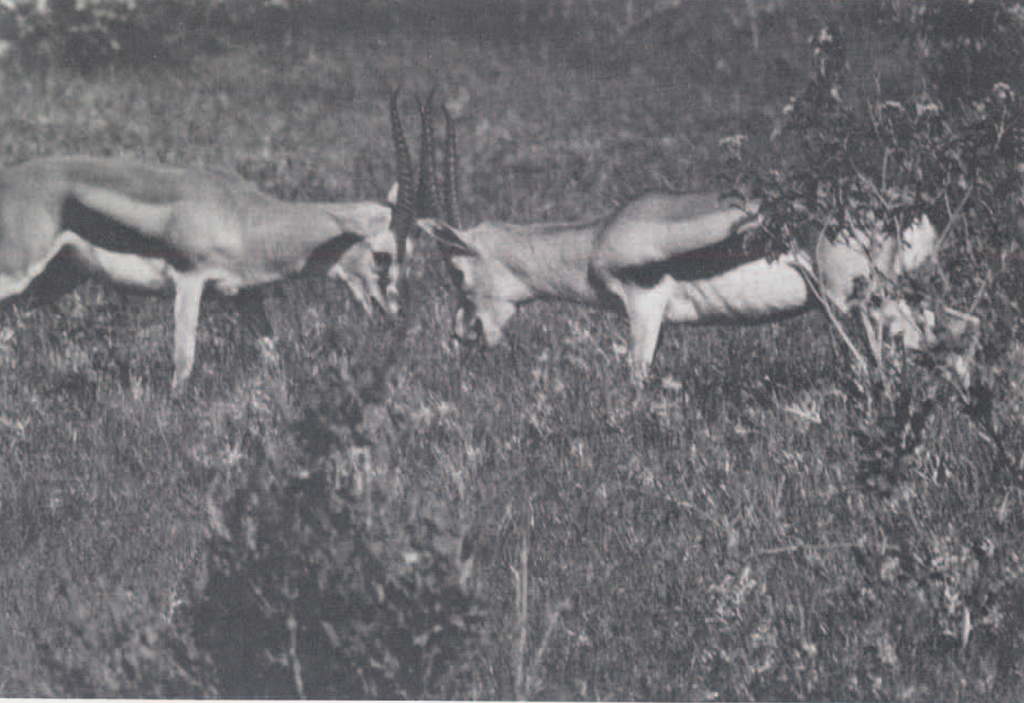
Yet, killings were not always fortuitous; several times I watched male baboons leave the troop as it made its way across an open field, move over to a herd of grazing antelope, and begin to walk a criss-cross pattern through the herd, eyes directed at the grass on either side. The male baboons also made similar excursions away from the troop into brushy areas, typical habitat of the dikdik, a tiny, fox-terrier-sized antelope. Both types of behavior appeared to be conscious efforts to look for suitable prey, and each resulted in a kill on occasion. Although the male baboons often took up the chase of a prey animal already being pursued by another baboon, there was no indication that the monkeys were cooperating with each other by doing so.
Once the prey animal had been caught, the baboons made no deliberate attempts to kill before beginning to eat it, just as many carnivores do not kill their prey right away but begin to eat it as soon as it is under their control. In the case of newborn antelope, the baboons usually began by eating the soft underside of the animal, and death quickly followed. Smaller animals, such as the button quail, virtually disappeared in a mouthful, but young antelope were carefully eaten. The baboons tore off chunks of meat by gripping the flesh with their front teeth, grasping their prey with two or more limbs, and pulling back their heads. A baboon often stripped the skin from an antelope limb with its front teeth, but in general the meat was torn from the inside of the skin and no attempt was made to skin it before eating it. I examined almost every kill site carefully after the baboons had finished eating and found that very little had been left uneaten; usually only scraps of skin or an occasional long bone remained. As a final morsel, the baboons often punctured the skull with their teeth and consumed the brain of their prey.
Once a prey animal had been captured, others of its species usually did little except to stand at a distance and watch it being eaten; however, several times female antelope were seen trying to rescue their young. On one of these occasions a female impala successfully defended her infant, apparently unable to get to its feet, from repeated attacks from at least two adult male baboons. In the course of chasing the baboons to their sleeping cliffs she managed to incite other impala herds in the same valley, first an all-male herd of fifteen animals and then a “harem” herd of one male and twenty-three females, with the result that
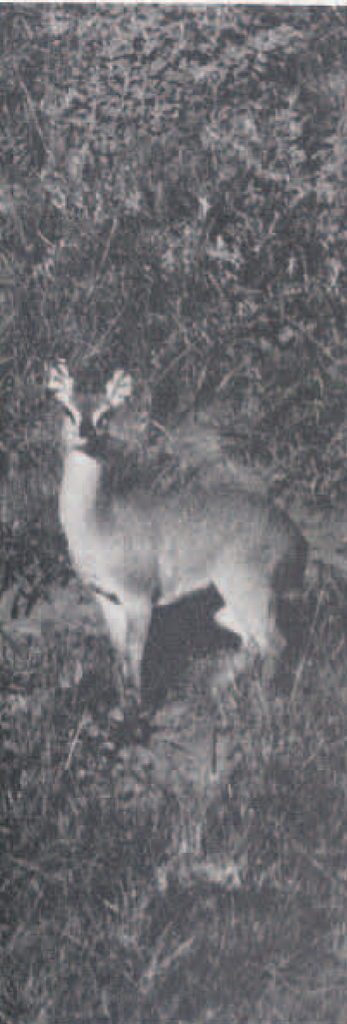
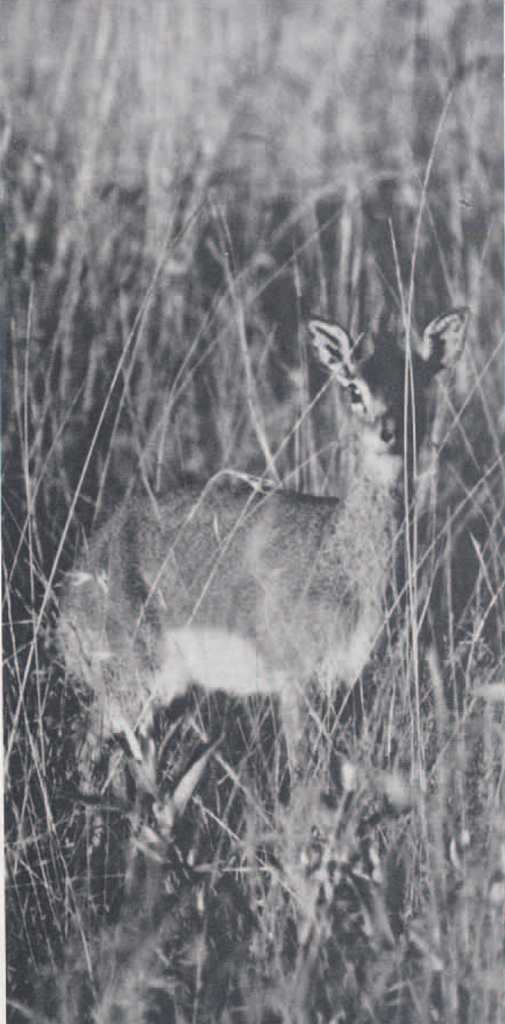
As already mentioned, adult female, juvenile and infant baboons were virtually excluded from meat-eating during the year I spent in Gilgil. There was an unequal distribution of meat among the adult males as well, however. Adult male Carl, who was the largest and most influential animal in the troop, caught and ate eighteen small animals, almost twice the number caught by the next most accomplished male, Sumner, who caught ten. Males Radcliffe, Alger and Moses caught five, three, and two animals respectively, while three were caught by females and six by males I could not identify at the time. These figures are deceptive, however, since Carl was able to add considerably to the amount of meat he ate by confiscating animals killed by other baboons immediately after they had been taken. Carl obtained an additional nine animals this way, making him the prime meat consumer of the troop, with twenty-seven animals eaten, or 57% of those caught. No other baboon came close to Carl in this regard, and Moses, at the other end of the scale, was forced to give up his two captures to Carl and finished with no animals to his credit. However, Moses, like other males, was often able to acquire some meat by being the first to grab the carcass after the original eater had abandoned it, and in this way he was still able to get more meat than any female.
I never saw a baboon share meat voluntarily with any other baboon, unless leaving the carcass on the ground when satiated can be called a form of sharing. On the contrary, a kill generally caused aggression levels in the troop to rise markedly. The most common reaction of the males to a kill by one of their number was to sit like a vulture within five yards of the meat-eater and stare at him, occasionally threatening him and any other males nearby. While relative status in the troop sometimes appeared to determine which baboon got most of a prey animal, this was not always the case. For instance, adult male Carl was often seen watching a male of lower status eat meat without any overt attempt to deprive him of it. In a similar incident, Radcliffe was able to drive Carl from the carcass of an infant gazelle, even though at the time Radcliffe was wounded and had become the least influential male in the troop. Thus, male status was not always a reliable predictor of behavior around a kill.
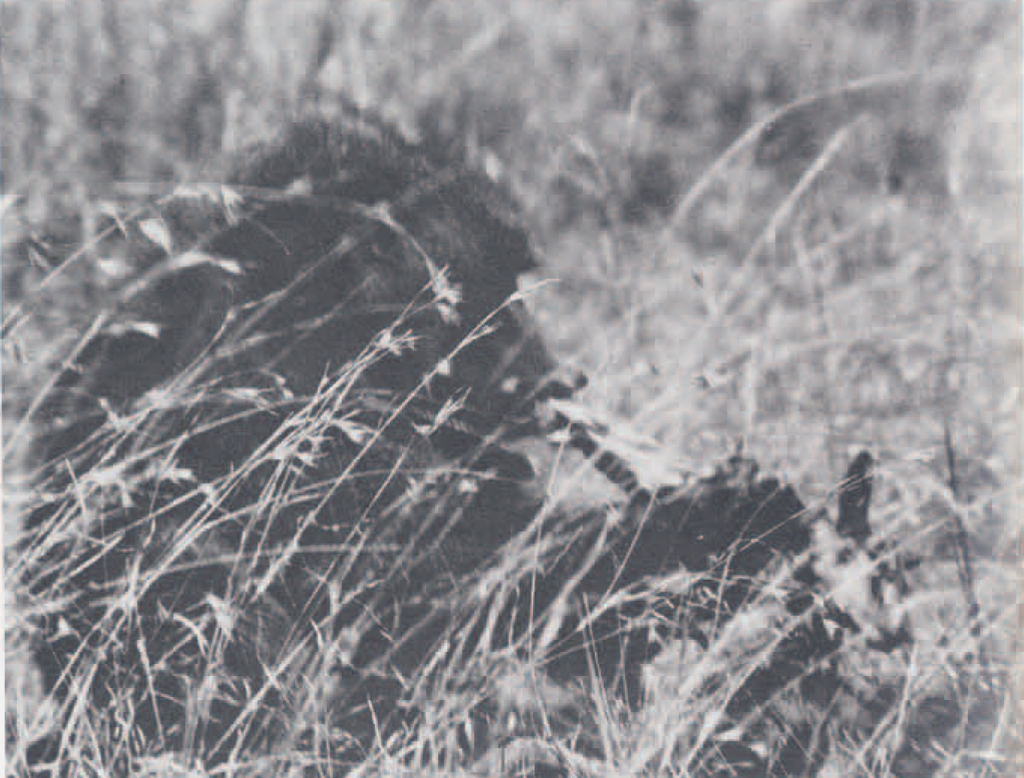
Baboons passed up carrion and ate meat only when either they or another baboon of the same troop had recently killed the prey animal. Thus the study troop ignored the carcass of a steinbok that had died less than 24 hours earlier, although several baboons passed within a yard of it during a troop movement. Similarly, a juvenile baboon was seen driving a large Verreaux’s eagle from the remains of a newborn mountain reedbuck, and, although the juvenile and several other baboons pawed at the dead antelope, they made no attempt to eat it.
Similarly, a juvenile baboon was seen driving a large Verreaux’s eagle from the remains of a newborn mountain reedbuck, and, although the juvenile and several other baboons pawed at the dead antelope, they made no attempt to eat it.
I could not watch every meat-eating bout until the last scrap of hide had been chewed by the last baboon involved, but most probably lasted less than an hour, with a hare taking about fifteen minutes to dispose of and the larger antelopes proportionately longer. The longest meat-eating session I saw lasted just under two hours, in part because of a complex set of aggressive interactions which resulted in four males and several other animals gaining access to the meat.
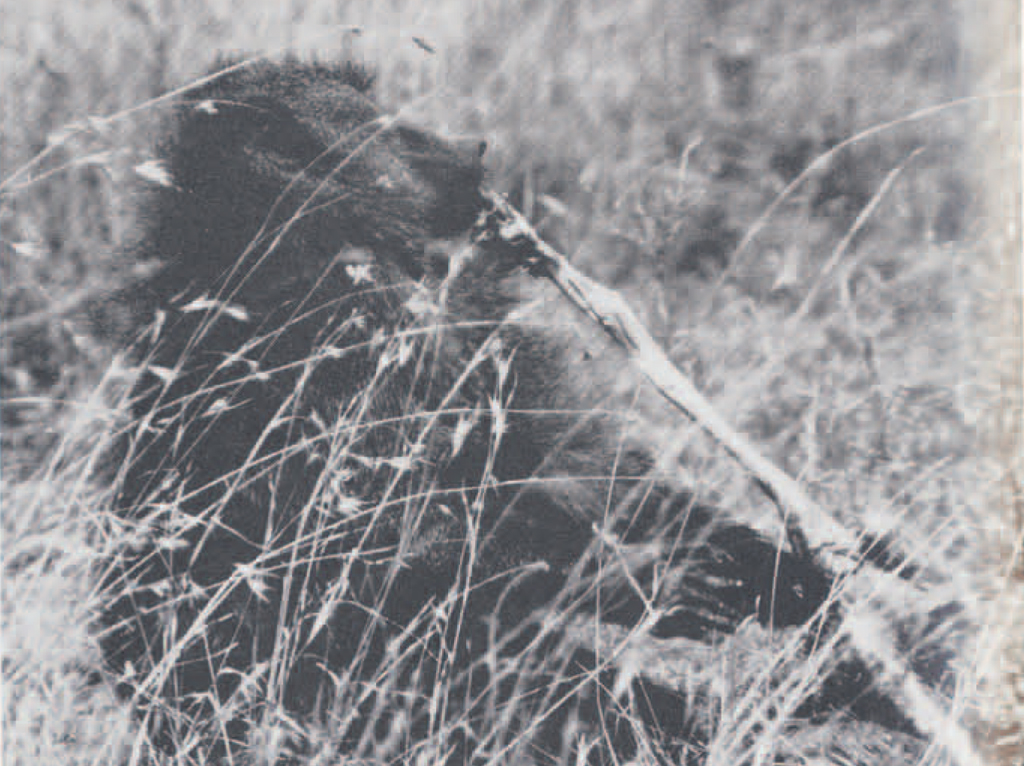
There seemed to be no correlation between external factors and the killing of small animals by baboons. For example, rainfall is seasonal in Gilgil, and I thought it likely that killing would increase during the dry season, when other sources of baboon food were relatively scarce and there was little cover available for prey animals. This did not happen, however. Similarly, Thomson’s gazelle are known to have birth peaks in other parts of East Africa, but, in contrast to what I might have predicted, there were no corresponding peaks in the killing and eating of newborn gazelles. The troop moved significantly farther during the hours beginning with 10:30 a.m. and 3:30 p.m. than at any other time, and this increased movement should have resulted in more chance discovery and killing of small animals. It did not. Finally, there were some occasions when the baboons seemed to kill several animals in a short period, but there were not enough examples of this clustering in time to prove that a successful kill was a major stimulus to additional killing.
Many nonhuman primates thrive in captivity on diets that include meat, and the fact that baboons kill and eat small animals in the wild has been known for some time. The South African anthropologist Raymond Dart has compiled a record of references in the early literature to the predatory habits of baboons, combining reports of attacks upon South African domestic stock by baboons with incidents in which baboons were seen to kill wild game. Dart’s purpose in collecting this sort of information was to show, in his words, “that predatory behaviour in a large terrestrial primate other than man was natural, and that such behaviour was consistent with the insectivorous origin and diet of primates.” If baboons could be shown to have a “perpetual” and “instinctive need” for animal protein, as Dart felt they had, then an equally good case could be made for Australopithecus, a primitive hominid first discovered by Dart. More recent field studies of baboons by different observers in different parts of Africa have confirmed that these monkeys in the wild will occasionally kill and eat small animals.
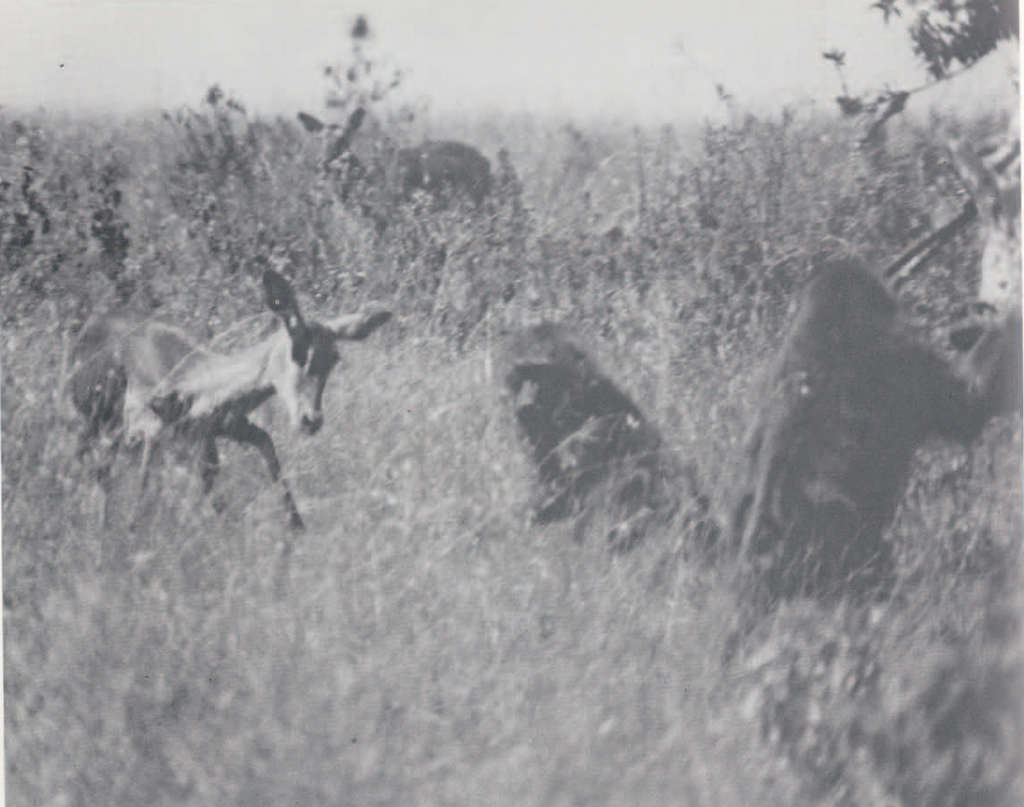
The chimpanzee is the only other nonhuman primate to regularly include small mammals in its diet. In the first ten years spent observing the chimpanzees that frequent the van Lawick-Goodall’s research station in the Gombe National Park, Tanzania, 95 animals were known to have been killed by chimpanzees and another 37 unsuccessful predatory attempts recorded. 65% of the prey animals were other primates, such as baboon infants, red colobus, blue monkey and red-tailed monkey, while bushbuck and bushpig accounted for the remainder. Japanese observers in Uganda have also seen chimpanzees eating meat on a small scale, and recent published reports describe two examples of chimpanzee cannibalism, one definite case in the Gombe National Park and one probable report from Uganda.
In both the baboons I studied and van Lawick-Goodall’s chimpanzees, the killing of small animals appeared to be an activity carried on only by adults and almost exclusively by males. In contrast to the Gilgil baboons, however, the Gombe chimpanzees cooperated with one another in obtaining a prey animal: several chimpanzees have been seen to block the escape routes of a young baboon while one of their number advanced slowly on the intended victim. Chimpanzees have also deliberately wrung or bitten into the neck of their prey before beginning to eat it, whereas I never saw the Gilgil baboons do this.
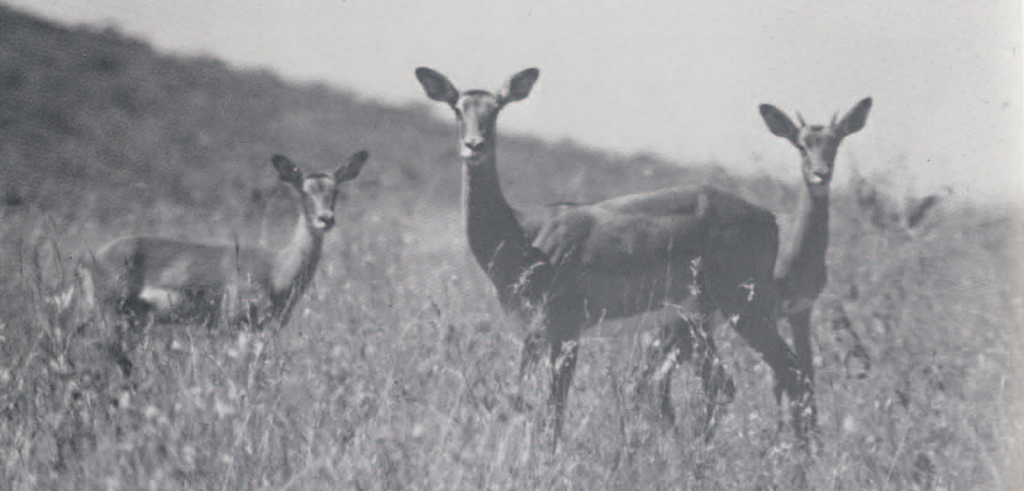
The Gombe chimpanzees seemed to treat a prey animal as common property for the first few minutes after a kill, and interference with any other ape trying to obtain the meat was rare. After several minutes had gone by, however, the chimpanzees with the major portion of the meat established some priority over it, and others had to beg for a share. Nonetheless, sharing almost always occurred. In ten years of observation, only two unshared kills were seen, and these were the simultaneous killings of two small bushpigs by two adult female chimpanzees when no others were present. When a Gilgil baboon killed a small animal, however, intense aggression often occurred, in which case competition over the prey animal sprang up quickly. Some of this activity resulted in depriving the captor of his prey, but a baboon was never seen to share meat voluntarily. This is in sharp contrast to the observations of Geza Teleki, who has made a special study of meat-eating in chimpanzees: in 43 hours spent watching meat being shared at the Gombe Stream, chimpanzees were never seen to fight for possession of it.
The Gombe chimpanzees also spent a great deal of time eating their prey. Teleki watched one meat-eating bout that lasted nine hours, and states that the mean duration of the predatory episodes he personally witnessed was just under four hours. The shortest episode was one hour and three-quarters, roughly the same amount of time as the longest feeding bout of the Gilgil baboons. At least part of the difference in time taken to eat a prey animal may have been the result of the Gombe chimpanzees’ habit of alternating mouthfuls of leaves with mouthfuls of meat, a habit the Gilgil baboons did not share. At the same time, the relatively tense atmosphere prevailing around a baboon kill encouraged the bolting of meat, while the relaxed chimpanzees were free to eat their prey at whatever rate they chose.
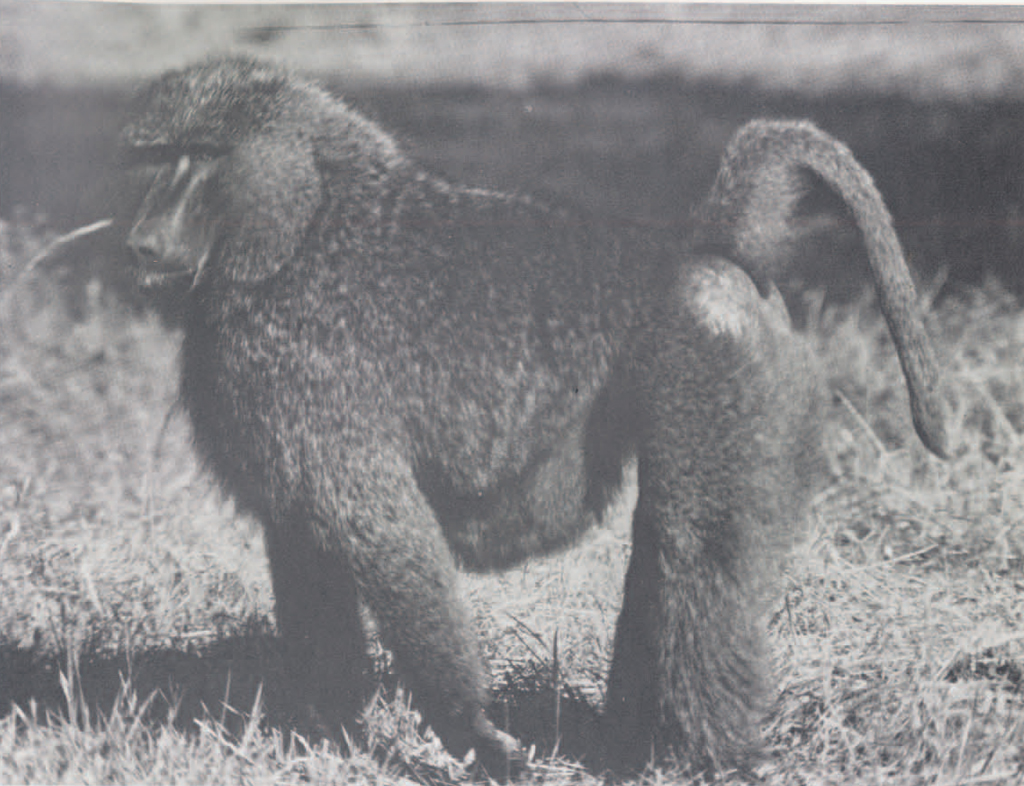
No complete analysis has yet been made of the protein content of baboon or chimpanzee diets in the wild, but it is apparent that protein from freshly-killed animals is a minor part of their overall food consumption. Moreover, in spite of the amount of predation seen in this one troop of baboons, it is worth emphasizing that adult females, juveniles and infants obtained very little meat while adult males spent only two per cent of their feeding time eating protein from animal sources. Meat was more widely distributed among the Gombe chimpanzees, but it still remained a relatively unimportant part of their diet. It is therefore highly unlikely that baboons, at least, have a “pressing,” “instinctive” need for animal protein, as Raymond Dart suggested.
At the same time, it is interesting to note that at least two species of nonhuman primate are capable of catching and consuming substantial numbers of small animals without any particular anatomical specialization. These animals have brains that make them capable of cooperative hunting, locomotor anatomy that enables them to catch small prey, teeth able to prepare animal food for ingestion, and a digestive apparatus well-equipped to make use of animal matter, including small amounts of bone. I know of nothing to indicate that these are recent evolutionary developments; indeed, while Dart’s contention that man’s immediate nonhuman primate ancestors were insectivores has not been proven, it is certainly likely that they were omnivores who made small animals, and especially other primates, a regular part of their diet.
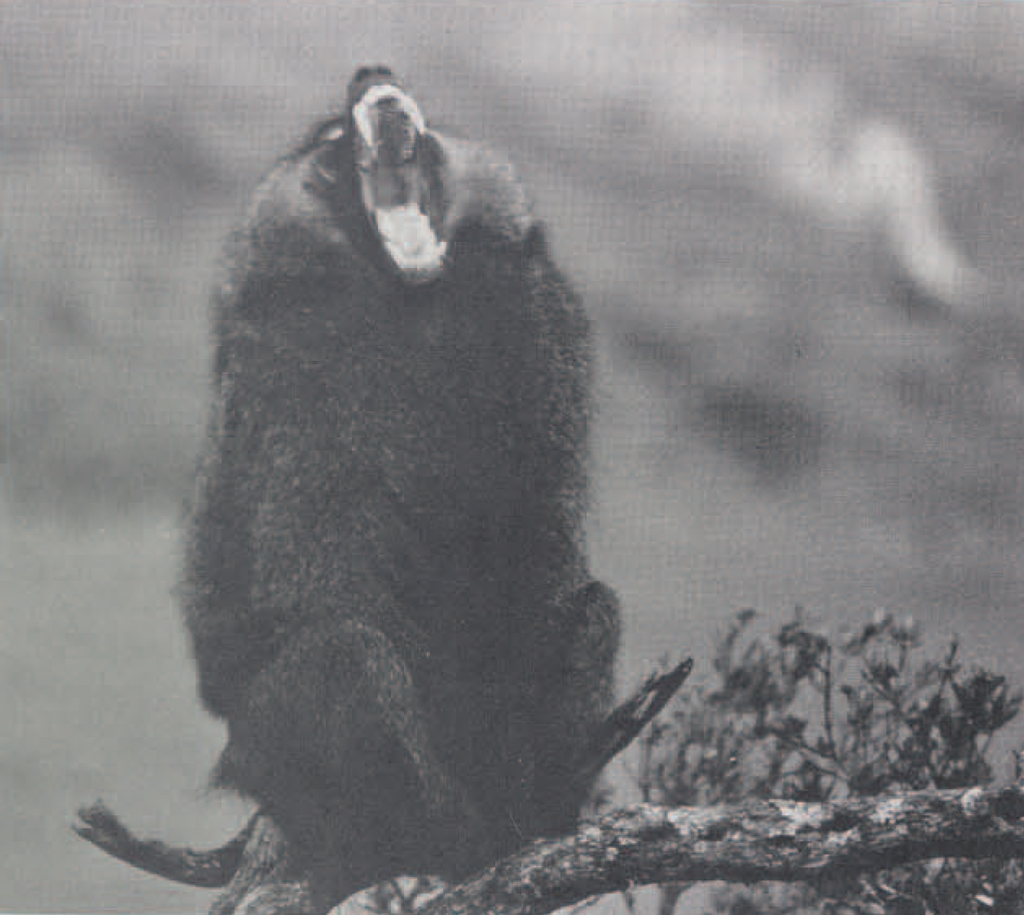
Many of the recent books emphasizing the biological basis of human behavior have isolated the beginning of hunting as a key development in human evolution, and the picture many of us retain is that of the Australopithecus-like creature in the film 2001—A Space Odyssey raising a bone and smashing it downward in dramatic slow motion. Some writers have even equated early meat-eating hominids with the Biblical story of Cain, adding what is surely unnecessary emotional freight to the whole issue. Human aggression is often traced back to the development of a propensity to kill other animals for food, and from there it is but a short step to man’s inhumanity to man in general and war in particular.
That some of us may kill our fellow men because our ancestors learned to kill other animals seems even less likely in the light of recent research in animal behavior. Experiments with cats, for instance, have shown that prey-catching and aggression in these animals are separate behavioral systems controlled by different parts of the brain, while the increasing number of field studies of wild animal populations has produced a number of examples of other creatures, carnivores and otherwise, which kill their own kind.
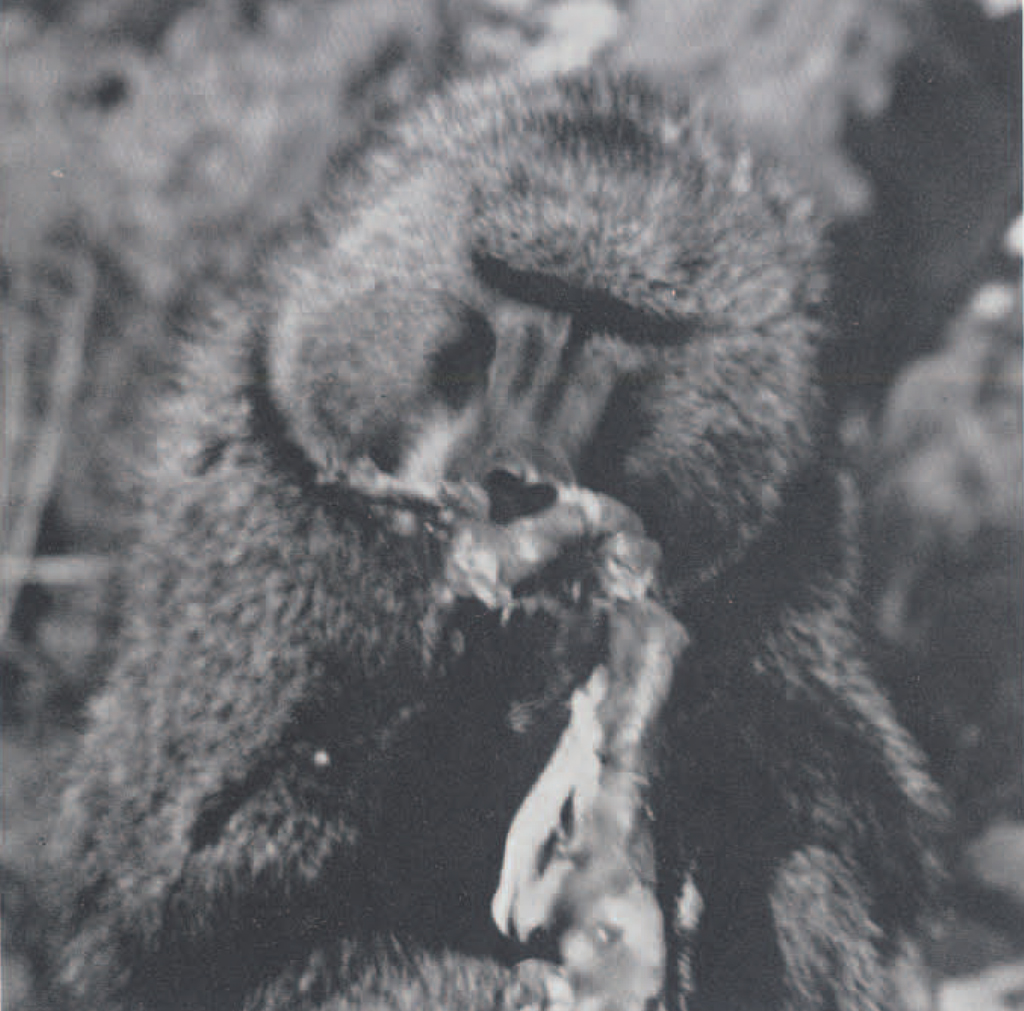
The evidence presented here, then, supports the notion that the development of predatory behavior may not have been the major shaping force in human evolution that some have called it. Instead, the diet of most of today’s human populations, a combination of animal and vegetable foods, is probably a continuation of an ancient primate pattern.
The Gilgil baboons have been followed without interruption by a series of observers since my study ended, and I plan to continue these observations with the assistance of students from the University of Pennsylvania for as long as possible. As our knowledge of these omnivorous baboons increases, one of our objectives will be to gain more insight into the origin and development of hunting and its importance in man’s evolution.
